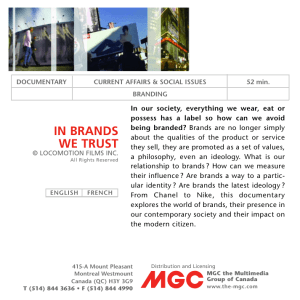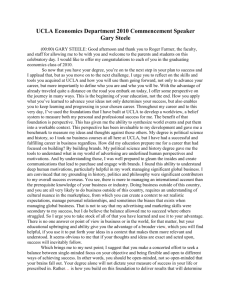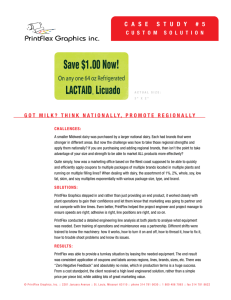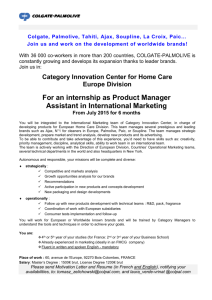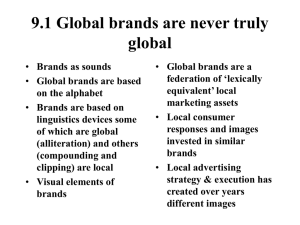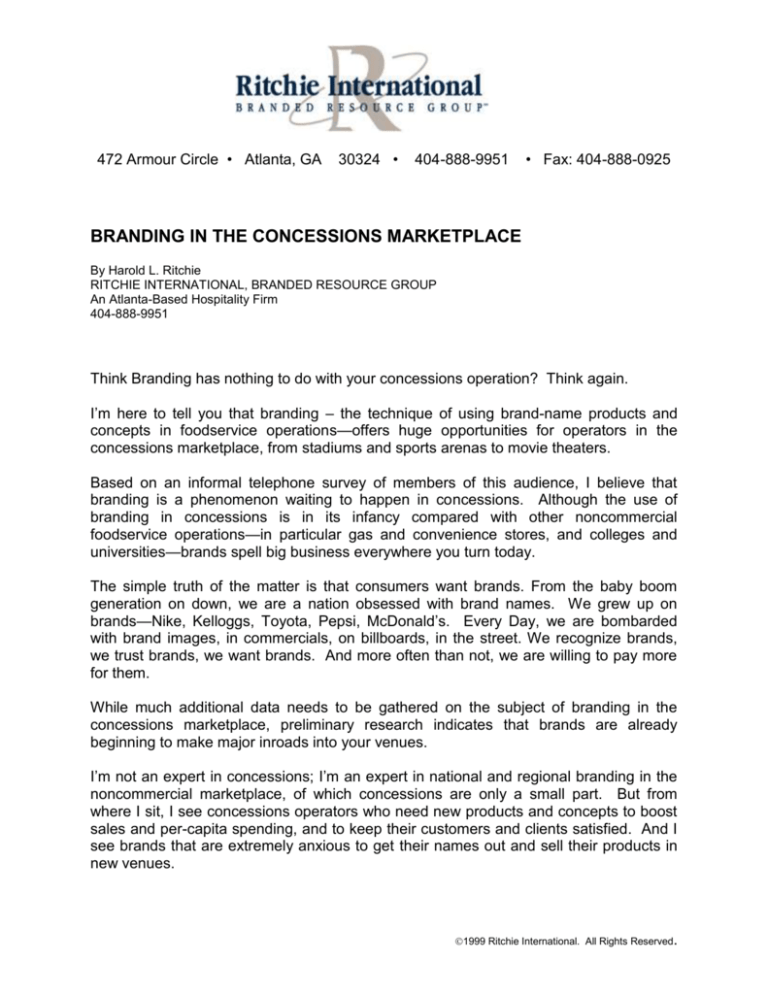
472 Armour Circle • Atlanta, GA
30324 •
404-888-9951
• Fax: 404-888-0925
BRANDING IN THE CONCESSIONS MARKETPLACE
By Harold L. Ritchie
RITCHIE INTERNATIONAL, BRANDED RESOURCE GROUP
An Atlanta-Based Hospitality Firm
404-888-9951
Think Branding has nothing to do with your concessions operation? Think again.
I’m here to tell you that branding – the technique of using brand-name products and
concepts in foodservice operations—offers huge opportunities for operators in the
concessions marketplace, from stadiums and sports arenas to movie theaters.
Based on an informal telephone survey of members of this audience, I believe that
branding is a phenomenon waiting to happen in concessions. Although the use of
branding in concessions is in its infancy compared with other noncommercial
foodservice operations—in particular gas and convenience stores, and colleges and
universities—brands spell big business everywhere you turn today.
The simple truth of the matter is that consumers want brands. From the baby boom
generation on down, we are a nation obsessed with brand names. We grew up on
brands—Nike, Kelloggs, Toyota, Pepsi, McDonald’s. Every Day, we are bombarded
with brand images, in commercials, on billboards, in the street. We recognize brands,
we trust brands, we want brands. And more often than not, we are willing to pay more
for them.
While much additional data needs to be gathered on the subject of branding in the
concessions marketplace, preliminary research indicates that brands are already
beginning to make major inroads into your venues.
I’m not an expert in concessions; I’m an expert in national and regional branding in the
noncommercial marketplace, of which concessions are only a small part. But from
where I sit, I see concessions operators who need new products and concepts to boost
sales and per-capita spending, and to keep their customers and clients satisfied. And I
see brands that are extremely anxious to get their names out and sell their products in
new venues.
1999 Ritchie International. All Rights Reserved.
472 Armour Circle • Atlanta, GA
30324 •
404-888-9951
• Fax: 404-888-0925
It stands to reason that over the next several years, as both brands and concessions
operators learn more about the business of branding in this highly specialized
marketplace, branding will grow to become a significant factor in concession.
What is branding, and where did it come from? The concept started inauspiciously
enough back in the early 1970s, when foodservice operators began serving brand-name
beverages like coke and Pepsi. The idea was good for the supplier, who got additional
brand-name exposure, and good for the operator, who benefited from an image boost
and often received financial incentives in the form of volume discounts. Today, that
concept of mutually beneficial “partnership” is still a cornerstone of the branding
concept, but the business of branding itself has grown immensely more sophisticated.
“Branding” in the 1990s is a lot of different things, from the bottle of Heinz ketchup on
the table at the local coffee shop to the new multimillion-dollar food court at a major
university which features full-scale fast-food units such as Taco Bell, Subway, Pizzeria
Uno and Burger King.
In the last five years, in fact, quick-service restaurants—or QSRs, as they are
sometimes called—have jumped into the branding bandwagon, offering their products
and concepts to foodservice operators in all segments of the noncommercial
marketplace.
It is this facet of the branding phenomenon that I believe carries the most potential for
concessions operators. QSR brands offer popular menu items, recognizable signage
and proven operating systems—turnkey “packages” that an operator can virtually plug
into his foodservice location.
This concept exists at several different levels. Product can simply be delivered to the
location by a local restaurant operator and sold via the host’s existing points of service.
This is done by many grade schools, for instance. Lacking the resources or the space to
install a branded kiosk or servery, the school makes every Friday “Domino’s Day.”
Domino’s gets extra sales and exposure, the kids get to eat Domino’s, and the school
gets extra sales and a satisfied customer.
1999 Ritchie International. All Rights Reserved.
472 Armour Circle • Atlanta, GA
30324 •
404-888-9951
• Fax: 404-888-0925
Or, the host—let’s say it’s a hospital this time--invites McDonald’s to come into the
cafeteria and operate a McDonald’s unit. In this scenario, the QSR leases the host site
on a percentage of sales, and pays the build-out. McDonald’s gets another site
placement and exposure, visitors and hospital staffers get to eat a well-marketed
McDonald’s hamburger, and the hospital received money for its leased space.
Everybody wins. This is a real estate deal.
Increasingly, however, noncommercial operators are opting to operate the QSR brands
themselves by becoming a licensee or franchisee. (What’s the difference? Basically, a
licensee pays royalties or a percentage of sales to the brand company; A franchisee
pays that percentage and also makes a contribution to the advertising and marketing
co-op, receiving certain territorial rights in return. Most noncommercial operators who
choose to operate the brand themselves prefer to be licensees, rather than
franchisees). However, you must carefully analyze the options and R.O.I. scenarios.
Food manufacturers are lining up for their share of the branding pie by developing their
own turnkey brand concepts. Well-known consumer brands like Oscar Mayer, Sara Lee
and Old El Paso have spent hundreds of millions of dollars to roll out their own branded
kiosks. The advantage of manufacturer brands—in addition to brand recognition and
turnkey operating systems—is the fact that unlike QSRs, manufacturers don’t charge
loyalties.
Then, too, noncommercial foodservice operators have been experimenting with their
own proprietary brands. These in-house brands—complete with signature products and
identifiable signage and trade dress—walk, talk and taste like real “street” brands. And
while the operator must develop and operate the brand himself, he exercises full control
over its success—no specs handed down from the corporate hierarchy, and no fees or
royalties.
But what does all of this mean to you, the concessions operator? It means that branding
is going to have a big effect on you in the future—we may not know what that is yet, but
it’s going to be very important. You need to react to market demands, and serving noname hot dogs and nachos is not leading –edge stuff.
1999 Ritchie International. All Rights Reserved.
472 Armour Circle • Atlanta, GA
30324 •
404-888-9951
• Fax: 404-888-0925
Here’s what a few of your colleagues in concessions are saying about the power of
brands:
“Every customer survey we’ve ever done indicates that they want to see more
brands. Consumers demand brand-name products instead of generic burgers
and pizza.”
“It’s a slam dunk: brands increase per-capita spending."
"Because of consumer acceptance of brands, there is less price resistance.”
Why, then, are concessions still a market that’s largely untapped for brands, particularly
in the area of movie theaters? Close to 50 percent of all colleges operate at least one
brand kiosk or cart, and almost 90 percent actively promote food brands on a daily basis
in their foodservice programs.
My sense is that this is too much of an economic decision, rather than an internal
growth strategy, and that many of you have only just begun to explore the potential of
brands. Branding in concessions is two or three years behind where it is in other
noncommercial venues. In theaters, the development is even less mature—many of you
may offer key brand-name products, but you haven’t begun to tap into restaurant
brands.
In concessions, it often comes down to a matter of logistics. Aging facilities, small
lobbies, narrow concourses, local health-department regulations, severely limited
service times—all of these factors are holding back the development of branding in the
concessions marketplace.
Some of your facilities may not generate the volume necessary to justify the brand
installation or build-out. In other cases, the facility’s owners do not understand the
benefits of branding in the consumer’s mind, and the potential for additional sales over
generic products. I believe all of these are problems that can be addressed, given time
and willingness on the part of all the parties involved.
1999 Ritchie International. All Rights Reserved.
472 Armour Circle • Atlanta, GA
30324 •
404-888-9951
• Fax: 404-888-0925
But I have to be completely frank with you on one rather sticky issue: “key money.”
Whether you call it co-op funds, an upfront fee, development monies or simply
baksheesh, these entry fees that are being demanded from brands are definitely
standing in the way of meeting consumer demand. They are already common in sports
concessions, and there’s some indication that movie concessions are moving in that
direction, with the family entertainment centers of the future.
And I’m here to tell you that the brands are a bit disgruntled about it. They have other
places to go—places that will get their name out and boost sales without necessitating
an upfront fee. Key money will be an inhibiting factor as to which brands will want to be
involved in concessions. Free sampling does not cut it with the major brands.
The cost of entry is steep: tens of thousands of dollars a year in fees and up to 40
percent or more in commissions. That may be fine in a huge arena that generates
millions of dollars’ worth of foodservice revenues, but there’s a limit to what a brand can
pay, and what kind of location it’s willing to pay if for.
Concessions don’t drive key money; the owners and marketers of the facility do.
Operators believe that it helps take some of the risk away from the contractor, but in
reality, it also takes away profits from the brand—and it’s not a win-win situation.
And by and large, these “development funds” are not being used to build the kiosk; they
are being used to pay the ball players and increase the stadium’s coffers. The
concessions operator never sees most of that so-called capital investment.
Furthermore, a lot of that cost is passed along to the consumer. The football fan who
pays $65 to see an NFL game and then springs for a $5 beer is actually kicking three
bucks of that back to the stadium. Consumers may not know where the money is going,
but they know they’re paying an arm and a leg for refreshments at the game, and at
some point they’ve got to start resenting that.
The simple fact is that with brands in concessions, you can talk about trial all you want.
Subway wants exposure. Pizzeria Uno wants exposure. Oscar Mayer wants exposure.
But the brands aren’t making that much money out there in concessionland—those of
you who participated in this survey said it yourselves.
1999 Ritchie International. All Rights Reserved.
472 Armour Circle • Atlanta, GA
30324 •
404-888-9951
• Fax: 404-888-0925
These brands are in it for the bigger picture and the longer term. What brand wouldn’t
want its name on the scoreboard of a 40,000-seat stadium, or one of its carts in the
entry concourse? What brand wouldn’t want to be associated with a team that had six
straight wins in a row, or was running sold-out dates through the season?
It’s this kind of exposure that makes the brands so anxious to do business with
concessions operators. Many of them will bend over backward to work with you. But the
best partnerships work when all the parties win by making money. I urge you not to kill
the goose that laid the golden egg by looking at a branding deal in terms of the upfront
fee you can get.
Look at it, instead, in terms of the increased sales, the amount of time you can keep
attendees in the facility, the turnkey operating systems and brand resources you can
take advantage of, and the intangibles like favorable image and customer satisfaction
that brands can impart. That’s what branding is all about.
By the same token, I realize that the brands have a lot of work to do in tailoring their
products and concepts to the needs of your marketplace. You can’t just take a kiosk that
worked in an airport terminal and plunk it down in the lobby of a concert hall—it’s a
different kind of business entirely. Brands need to do their homework and figure out
better ways to meet the particular needs of the concessions marketplace. This is why, in
my opinion, the NAC must be heavily involved in determining what the business case is
for brands.
The brands need to develop more food products and services that can withstand the
intense peaks and valleys or event service. They need to design new points of service
that can be placed in smaller areas or be retrofitted into existing concessions stands.
They need to invest in training programs for a different type of foodservice staff. They
need to invest in promotions and trade dress that are appropriate to stadiums, ballparks
and movie theaters, and brands must figure out, with technologies, how best to shorten
the transaction time and reduce lines. In short, the brands need to learn how to speak
your language.
Let's explore some of the other realities of branding in the concessions marketplace
today. What kinds of brands work best and why? How successful are they? What are
concessions operators looking for from brands? What is “the state of the state" on
brands?
1999 Ritchie International. All Rights Reserved.
472 Armour Circle • Atlanta, GA
30324 •
404-888-9951
• Fax: 404-888-0925
Truth: brands may not allow you to increase prices, but they help to support an existing
premium structure. Let’s face it, concessions food is no bargain. Prices are already way
above “street” levels, and they’ve gotten about as high as they’re going to get. If owners
are looking for enhanced revenues from foodservice concessions, but you can’t raise
prices any more, the next step has to be introducing new products that will increase percapita spending. We call it activation—going deeper into your current business base to
optimize sales.
Concessions operators report that brands are capable of driving increases of 8 to 12
cents per person or more. I think you’d be hard-pressed to come up with another
avenue for increasing sales that’s that effective.
Truth: Not all brands can work in the concessions marketplace. People don’t come to
ballparks or the movies to eat a sandwich. However, they certainly do in Detroit Tigers
stadiums and others. They come a few minutes early and grab a bag of popcorn and a
soda, or they wander out during a slow period, or they storm out during that 15-minute
intermission.
Products that can be prepped ahead or held or made very quickly are the only ones that
stand a chance of being successful in a concessions scenario: Pizza (By the slice or
personal-size); tacos; nachos; pretzels; hot dogs. Some of the most popular branded
menu items in other noncommercial venues—made-to-order sandwiches, rotisserie
chicken, premium hamburgers—have limited applicability in concessions. Sorry.
Truth: brands are inextricably tied to the events and environment that affect your facility.
If there’s a baseball strike or your team has a losing streak or it rains for a week straight,
you and everyone else that has anything to do with your facility is going to suffer. If a
brand-new multiplex theater opens down the block or the city closes the parking garage
next door, your sales are going to take a nose dive, and so are your brand partners’.
More factors impact your business than perhaps any other noncommercial segment.
And everybody has to realize that going in.
Truth: if you are not the brand licensee, you may be at the mercy of the local QSR
operator. Holding the license or franchise yourself probably only makes sense at a
facility that is in use year-round, day in and day out, such as a theater or a convention
center. Therefore, in most cases you will be working with whoever is available in the
local market that day. Someone who may be a franchisee himself, because a brand
simply can’t afford to dedicate a manager to your individual unit.
1999 Ritchie International. All Rights Reserved.
472 Armour Circle • Atlanta, GA
30324 •
404-888-9951
• Fax: 404-888-0925
That means that from city to city, venue to venue, you’ll see varying degrees of
involvement and commitment. You may not be working with the same operator each
time, and you may not get the same quality level. And unfortunately, the customer is
going to blame you, the facility’s manager, not the brand for the lack of quality.
So, it’s important to try to get the right fit, to try and find the local franchisee who’s going
to be willing to do the local marketing, to pay attention to the quality levels, to ensure
that the point of sale is being operated properly. In this case, the personnel is as
important as the brand concept and system. I highly advise you to work only with
corporate personnel when looking to do business with a brand. Do not call the local
Pizza Hut office -call the corporate headquarters.
Truth: there is great opportunity with local and regional restaurant concepts, as long as
they have their act together. It’s not just the big national franchise systems that you
should be looking at. Smaller players, particularly in markets that are known for certain
specialities—like barbecue in Texas or chili in Cincinnati—can offer tremendous value
and sensitivity to the concessions. Not only will they be anxious for the opportunity to
sell their products to a wider audience, they will add regional taste and preferences to
your foodservice operations.
Be careful, however: brands like McDonald’s and Pizza Hut didn’t get to be the size they
are by accident. They bring tremendous resources to the table in the form of complete
operational systems, training support, and marketing clout, resources which simply
cannot be matched by smaller companies. Be sure that any brand partner you go into
business with can deliver on all promises.
Truth: you can turn to brands for financial assistance as well as operational support.
The issue of key money aside, one of the reasons brands make such appealing
partners is that they have marketing funds for development allocated for making
investments in facilities, signage, training and testing. They may be willing to offer
discounts on purchase prices or licensing fees if certain sales levels are met. They are
often more than happy to design a service station for you, and may even pay to build it.
These are issues you should take a look at when deciding to brand or selecting a brand
partner.
1999 Ritchie International. All Rights Reserved.
472 Armour Circle • Atlanta, GA
30324 •
404-888-9951
• Fax: 404-888-0925
Truth: most concessions operations have very little time to recoup investments of any
kind. If your facility is only in use ten times a year, don’t expect the brands to be beating
down your doors to get in. Many owners and concessions operators are stepping up
their efforts to use the facilities more, by bidding for additional sports franchises, and by
aggressively marketing their venues for concerts, festivals, and other events. As the
number of days the lights are on increases, branding becomes more feasible—and the
brands will become that much more interested.
Truth: the brands can get into the concessions business, too. Fast-food giants like
McDonald’s are known to be looking into operating concessions themselves, rather than
working through the contractors or in-house concessions management. It’s only a
matter of time—this thing called branding is evolving. Don’t have your head in the sand.
So far, their efforts have been spotty. But once they figure out the mechanics of the
concessions business, what’s to prevent them from approaching the owners directly, or
going after the same bids you are? Bring them in to operate a branded station, and they
learn your business. Attempt to keep them out, and they’ll make a pitch right to the
owner. Think about that the next time you’re tempted to ask for more key money.
Truth: branded foods may never outperform core products, but they offer diversity and a
competitive advantage. Arenas may be serving pizza and nachos and even sushi but,
as you know, snacks like popcorn, hot dogs, candy and sodas still account for about 80
to 85 percent of concessions sales—and don’t look for that to change fundamentally
any time soon.
What these branded products do offer, however, is added value. For the customer—
especially the season ticket holder or regular attendee—they offer diversity and a
change to try something different. For concessions management, brands are a
marketing ploy—they offer concrete proof to the owners that you can do something no
one else does.
Truth: brands can change your product mix. A well-executed brand is capable of
outperforming you in your own operations—it can actually take business away from your
hot dog cart or popcorn stand. But remember that a brand can also add incremental
sales, tempting the customer who wouldn’t have otherwise had anything, and that the
brand is paying a percentage of its sales to you.
1999 Ritchie International. All Rights Reserved.
472 Armour Circle • Atlanta, GA
30324 •
404-888-9951
• Fax: 404-888-0925
Truth: brands can add a product line that you couldn’t possibly. Let’s say you want to
add fried chicken or pizza to the product mix. This is an excellent place to bring in a
brand, because the brand will invest the $100,000 necessary to put in fryers and venting
systems or ovens. You’ll only get a percentage of sales, rather than all the sales, but
you won’t have to put up any of your own capital, either.
The new product will also benefit from the millions of dollars’ worth of advertising that
the brand has spent promoting its name out there in the marketplace. You won’t have to
educate the consumer about your new fried chicken or pizza, because he already
knows all about it.
Truth: location is just as important as product. Entrance ramps are good, main
concourses are good—opposite the restroom is great. Carts may work better than
kiosks because the investment is much lower relative to sales; during events, people
aren’t lingering anyway—they just want to grab and go.
Truth: brands may cost a little more going in. Product cost and labor cost are often more
with brands. So be sure to look at the big picture. Are margins better? Is volume higher?
Does having a turnkey system in place free you up for other things?
Truth: look at what makes the customer happy, not just at the sales reports. Part of what
successful concessions are all about is customer satisfaction, and brands can help you
achieve that. But the real puzzle is, which brands? With certain products, the answer
may be obvious: say the work “taco,” and the Taco Bell name immediately springs to
mind. But with a product like pizza or hamburgers, the field becomes wide open.
Take time to do customer research; find out which brands deliver the proper
combination of customer satisfaction and financial performance. Because of regional
preferences or other factors in the local market, for instance, one brand of pizza may
prove much more popular in your location. Pay attention to how well various brands in
your area perform, and how much they advertise and promote. Also look at smaller
brands that may be strong locally.
Truth: Don’t overlook the power of self-branded concepts. While national QSR and food
brands carry built-in consumer awareness and the availability of turnkey systems and
operational support properly executed signature brands are also an important part of
many branding strategies.
1999 Ritchie International. All Rights Reserved.
472 Armour Circle • Atlanta, GA
30324 •
404-888-9951
• Fax: 404-888-0925
In fact, many concessions operators use national brands as an “anchor,” with in-house
brands providing flanking support. The beauty of an in-house brand is that it can be
changed much more easily than a national brand, or it can be rolled out in time for a
particularly large event or a new season. If customer boredom sets in, if a team’s
fortunes change, or if attendance peaks or dips, in-house brands could be the answer.
In-house brands are also more in line with the funds and space available in smaller
venues.
Large management companies like Aramark, with the resources to develop their own
strong signature brands, use these self-branded concepts heavily as anchors,
spreading investment dollars out over a wide variety of branded serveries.
Truth: expect a few branded concepts to take off shortly. What’s coming down the pike?
The operators we spoke to singled out a small but significant sampling of brand
concepts that they’re particularly interested in for the near-term.
Pretzels seem to be the product that’s about to happen next. In this small category
that’s related to specialty baked goods, there are a number of relatively new companies
that specialize in hot gourmet pretzels, often with specialty toppings or flavor profiles,
made in view of the customer. While no single brand has emerged as the clear winner
in this particular sweepstakes, you can be certain that the category itself will grow
significantly in the next few years.
Specialty coffee is another category that shows all the signs of being on the verge of
something big. Although not appropriate for all climates and all seasons, espresso,
cappaccino and gourmet brewed coffee, along with “go-with” baked goods like biscotti
and pastries, are riding the crest of a wave of consumer popularity.
Mexican products are also high on the wish lists of many concessionaires, including
nachos, tacos, burritos and other finger-food items.
In actuality, I think that there are a number of brands which, when properly focused and
aimed at the concessions market, will prove to be extremely successful—we have not
even begun to consider all the possibilities.
Brands and concessions offer tremendous potential for synergistic, mutually beneficial
ways of doing business. I’d like to close with one observation that alludes to the
distances branding can go in the concessions marketplace.
1999 Ritchie International. All Rights Reserved.
472 Armour Circle • Atlanta, GA
30324 •
404-888-9951
• Fax: 404-888-0925
Theaters represent one of the last frontiers for branding. And yet look what’s poised to
happen: The old notion of the corner “cinema” is evolving into the totally new concept of
family entertainment centers, complete with huge multiplex theaters, video games,
virtual-reality rides, miniature golf, retail shops and, yes, restaurants. These
entertainment complexes are true destinations; there are only a handful open around
the country now, but their initial success is already promising to make them the wave of
the future. And if this doesn’t represent an enormous opportunity for branded
concessions operations, I don’t know what does.
1999 Ritchie International. All Rights Reserved.



